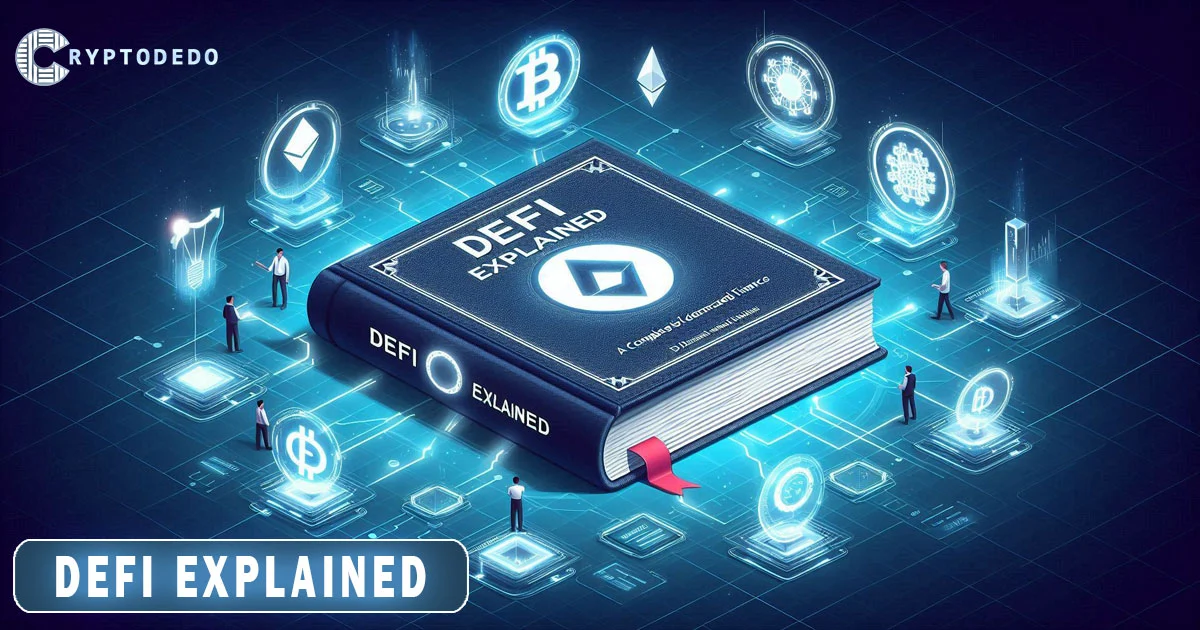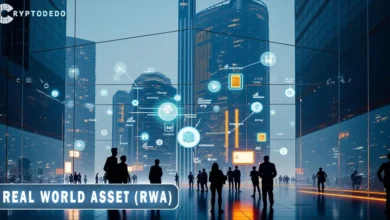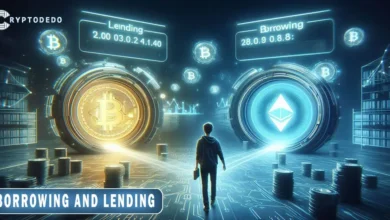DeFi Explained: A Complete Guide to Decentralized Finance
DeFi: Revolutionizing Finance through Decentralization

What is DeFi? Introduction to Decentralized Finance
DeFi, short for Decentralized Finance, represents a paradigm shift in how we think about traditional financial systems. Built on blockchain technology, DeFi seeks to replace conventional financial intermediaries such as banks, brokers, and exchanges with decentralized protocols.
These protocols operate autonomously using smart contracts — self-executing pieces of code that define and enforce the terms of an agreement without the need for intermediaries.
At its core, DeFi aims to democratize access to financial services. It offers anyone with an internet connection the ability to borrow, lend, trade, and invest without relying on centralized institutions.
This system opens the door to financial inclusion, especially for populations underserved by traditional financial institutions, such as people in developing countries or those without access to banks.
DeFi: Empowering a New Era of Financial Freedom and Inclusion
As we move deeper into the digital age, traditional financial systems struggle to keep pace with the demands of a rapidly evolving world.
DeFi, or Decentralized Finance, stands at the forefront of a financial revolution, offering individuals around the globe unprecedented control, accessibility, and freedom over their assets. By eliminating the barriers set by centralized institutions, Decentralized Finance paves the way for a more inclusive and transparent financial ecosystem, one where anyone, regardless of location or background, can participate and prosper.
In this section, we’ll explore how Decentralized Finance is not just disrupting the financial status quo, but also empowering people to take charge of their financial futures. We’ll delve into the key opportunities DeFi offers and how it’s transforming lives by providing tools that are redefining what financial freedom truly means.
Why is DeFi Important?
The importance of Decentralized Finance lies in its ability to offer an open, permissionless financial system where individuals have full control of their assets.
In the current centralized finance (CeFi) system, users must trust banks and other institutions to manage their assets, but DeFi eliminates the need for trust by using immutable blockchain technology.
Decentralized Finance also stands out because it operates 24/7, without the need for business hours or human intervention, providing unparalleled accessibility. Moreover, transaction costs can be significantly reduced by cutting out middlemen.
DeFi vs CeFi (Centralized Finance)
Understanding Centralized Finance
Before diving deeper into DeFi, it’s essential to understand the characteristics of traditional CeFi. In a centralized financial system, entities like banks, governments, or financial institutions control the flow of money and manage accounts.
For instance, if you want to transfer money, you rely on a bank to process the transaction. If you wish to invest in stocks or bonds, you may need a brokerage firm to facilitate the trades.
How DeFi Differs from CeFi
Control and Custody:
In CeFi, institutions hold custody of your funds. In DeFi, you control your private keys, which gives you full ownership of your assets.
Transparency:
CeFi operates behind closed doors, and users must trust that their funds are managed appropriately. Decentralized Finance, on the other hand, offers full transparency since transactions are recorded on public blockchains that anyone can view.
Fees and Costs:
CeFi services often involve fees, from account maintenance charges to transaction fees. Decentralized Finance can reduce costs through automated smart contracts and peer-to-peer systems, though users may still pay gas fees (transaction costs on the blockchain).
Security and Trust:
In CeFi, institutions use centralized servers, making them susceptible to hacking or data breaches. In Decentralized Finance, security is decentralized across nodes, though vulnerabilities still exist in poorly written smart contracts.
Accessibility:
CeFi is often limited by geographic location or regulatory restrictions. Decentralized Finance is permissionless and can be accessed by anyone globally, provided they have an internet connection and cryptocurrency.
The Hybrid Approach: Many financial systems are moving toward hybrid models, combining the best aspects of CeFi and DeFi. These systems allow for a balance of regulatory compliance, security, and user autonomy.
Companies like Binance and Coinbase have begun integrating Decentralized Finance services into their platforms to offer a bridge between traditional finance and decentralized finance.
How Does DeFi Work?
Blockchain Technology as the Foundation
DeFi is primarily built on blockchain technology, particularly Ethereum. Ethereum’s smart contracts allow developers to create decentralized applications (DApps) that facilitate financial transactions without the need for centralized control.
Smart Contracts: Smart contracts are the core innovation driving DeFi. These are self-executing programs stored on the blockchain that automatically enforce the terms of a transaction once predefined conditions are met.
For example, in a lending DeFi protocol, a smart contract may dictate that if a user deposits collateral, they are automatically able to borrow an asset without manual intervention.
Decentralized Applications (DApps):
DApps are the user interfaces that enable people to interact with smart contracts on the blockchain. These applications are decentralized, meaning they don’t rely on a single server or control point. Examples of popular DeFi DApps include:
Uniswap: A decentralized exchange (DEX) where users can trade cryptocurrencies directly without a middleman.
Aave: A lending and borrowing platform that allows users to earn interest by lending or borrow assets by providing collateral.
Compound: A protocol that allows users to deposit crypto into liquidity pools and earn interest or take out loans.
Tokenization in DeFi:
Tokenization plays a key role in DeFi ecosystems. Tokens are digital assets that represent value and can be traded or used within the DeFi space.
The most common token standards in DeFi include ERC-20 (fungible tokens like DAI and USDC) and ERC-721 (non-fungible tokens, or NFTs). Tokens facilitate a variety of functions in DeFi, from governance to liquidity provision.
What is Liquidity in DeFi?
Liquidity Defined:
In traditional finance, liquidity refers to the ease with which an asset can be converted into cash without significantly affecting its price. In Decentralized Finance, liquidity refers to the availability of funds in a market or platform to facilitate transactions.
Liquidity Pools:
Liquidity in DeFi is primarily provided by liquidity pools, which are smart contracts that hold pairs of tokens.
Users, called liquidity providers, can deposit their assets into these pools and, in return, earn a portion of transaction fees or additional tokens. These pools enable decentralized exchanges (DEXs) like Uniswap and SushiSwap to function smoothly without needing an order book like traditional centralized exchanges.
Impermanent Loss:
A key risk for liquidity providers is impermanent loss, which occurs when the price of the deposited tokens fluctuates significantly.
When this happens, liquidity providers may end up with fewer tokens than they would have had if they simply held onto the tokens instead of providing them to the pool. However, the fees or rewards earned from providing liquidity can offset this risk in many cases.
Liquidity Mining:
Liquidity mining is a process by which users earn additional rewards or tokens for providing liquidity to a platform. This incentivizes more users to participate and adds liquidity to the DeFi ecosystem, ensuring that the platforms remain functional and liquid.
Pros and Cons of DeFi
Pros of Decentralized Finance:
Accessibility: Decentralized Finance opens up financial services to anyone with a smartphone or internet connection. There are no barriers such as credit checks, location restrictions, or the need for a bank account.
Control Over Assets: Unlike centralized systems, DeFi gives users full control over their assets. This removes the need for intermediaries and reduces counterparty risk.
Transparency: All transactions on DeFi platforms are recorded on public blockchains, ensuring a high level of transparency and auditability.
Potential for High Yields: DeFi platforms often offer higher returns on assets compared to traditional savings accounts or investments. For example, yield farming and staking can provide double-digit annual percentage yields (APY) in some cases.
Interoperability and Innovation: DeFi platforms are highly interoperable, allowing for seamless integration between various DApps. This fosters rapid innovation, as developers can build on existing protocols to create new financial products.
Cons of Decentralized Finance:
Security Risks: DeFi is not without risks, and smart contracts can be vulnerable to bugs or malicious attacks. Even high-profile platforms have been hacked, resulting in significant losses for users.
Volatility: The cryptocurrency market, which underpins DeFi, is highly volatile. The value of assets can change dramatically within short periods, posing significant risk to investors.
Impermanent Loss: Liquidity providers may suffer from impermanent loss, which can diminish the returns on their investments.
Regulatory Uncertainty: As DeFi is a relatively new and decentralized field, it operates in a legal gray area in many regions. Governments and regulatory bodies are still determining how to approach DeFi, which could lead to future restrictions or interventions.
User Error: In DeFi, users are responsible for safeguarding their private keys and managing their wallets. Mistakes like losing private keys or sending assets to the wrong address can result in permanent loss of funds, with no recourse for recovery.
Beginner’s Guide to Decentralized Finance
Step-by-Step Guide:
Understand Blockchain and Crypto Basics:
Before diving into DeFi, it’s important to have a basic understanding of blockchain technology, cryptocurrencies, and how digital wallets work. Bitcoin and Ethereum are the foundational cryptocurrencies most commonly used in DeFi.
Create a Wallet:
To get started with Decentralized Finance, you need a cryptocurrency wallet like MetaMask, Trust Wallet, or Coinbase Wallet. These wallets are decentralized and non-custodial, meaning only you control the private keys.
Get Ethereum or Other Cryptos:
Since Ethereum is the most widely used platform in Decentralized Finance, you’ll likely need some ETH to interact with DeFi protocols. You can purchase ETH from an exchange like Coinbase, Binance, or Kraken and transfer it to your wallet.
Choose a Decentralized Finance Platform:
Some of the most popular DeFi platforms for beginners include:
Uniswap: A decentralized exchange for swapping tokens.
Compound: A protocol for lending and borrowing.
Aave: Another popular lending and borrowing platform.
Start Lending or Staking:
Once you have a wallet and some crypto, you can start using Decentralized Finance platforms to lend your assets, provide liquidity, or stake your tokens to earn passive income. Make sure to start small and get comfortable with the platform’s features.
Keep Learning and Experimenting:
The DeFi space evolves rapidly, with new platforms and opportunities emerging constantly. Continuously educate yourself, read documentation, and experiment with different protocols to discover the best strategies for earning in Decentralized Finance.
How to Make Money with DeFi?
1. Lending and Borrowing:
DeFi platforms like Aave and Compound allow users to lend their assets and earn interest. Borrowers must provide collateral, ensuring lenders’ funds are secure.
2. Yield Farming:
Yield farming involves providing liquidity to decentralized exchanges (DEXs) and earning rewards in the form of interest or governance tokens. This process can generate significant returns, but it also carries risk due to price volatility and impermanent loss.
3. Staking:
Staking involves locking up tokens in a DeFi protocol to support network security. In return, users receive staking rewards. Staking is a popular option for platforms like Ethereum 2.0 and Polkadot.
4. Trading:
Users can trade DeFi tokens on DEXs like Uniswap or PancakeSwap, taking advantage of price fluctuations. Trading in Decentralized Finance allows for quick transactions without needing a central authority, but it can be risky due to market volatility.
5. Participating in Governance:
Some Decentralized Finance platforms allow users to participate in protocol governance by holding governance tokens. These tokens grant voting rights on proposals, and some platforms reward users for participating in the governance process.
Steps to Start Investing in Decentralized Finance
Set Up a Wallet: Choose a reliable non-custodial wallet such as MetaMask or Trust Wallet to store your assets.
Buy or Transfer Cryptocurrency: Acquire some cryptocurrency, most likely Ethereum (ETH), as it’s the most commonly used in DeFi.
Explore DeFi Protocols: Research popular protocols like Aave, Uniswap, Compound, and SushiSwap to see what aligns with your investment goals.
Start Small: It’s always a good idea to begin with a small investment to test the waters, particularly if you’re new to the space.
Diversify Your Portfolio: Avoid putting all your funds into one protocol or liquidity pool. Diversify across multiple platforms to mitigate risk.
Risks of Investing in Decentralized Finance
The Dark Side of DeFi: Risks and Challenges in the Decentralized World
While DeFi promises a world of financial freedom and inclusion, it is not without its dark side. Despite its rapid growth and innovation, there are significant risks and challenges that users and investors must be aware of before diving into the decentralized finance ecosystem. As exciting as Decentralized Finance might seem, the very features that make it attractive — such as autonomy and lack of intermediaries — also introduce considerable drawbacks.
1. Smart Contract Vulnerabilities: One of the most critical risks in DeFi is the reliance on smart contracts. While smart contracts are designed to be tamper-proof and secure, they are still written by humans and are, therefore, prone to coding errors or exploits.
Hackers have taken advantage of these vulnerabilities in numerous high-profile Decentralized Finance hacks, leading to the loss of millions of dollars. In some cases, once funds are stolen, there’s little recourse for recovering them, as DeFi lacks the traditional oversight and insurance systems of centralized finance.
2. Lack of Regulation and Consumer Protection: The decentralized nature of Decentralized Finance means it operates in a largely unregulated environment. While this provides users with freedom and autonomy, it also means there’s no safety
3. Market Volatility and Risk of Loss: Theimpermanent loss, where the value of assets provided to liquidity pools can change unfavorably, leaving users with lower returns than expected. For inexperienced users, these risks can lead to substantial financial loss, especially if they’re not familiar with how DeFi protocols function.
4. Complexity and User Errors: Decentralized Finance can be incredibly complex, even for seasoned investors. The technical knowledge required to navigate wallets, private keys, smart contracts, and decentralized exchanges often overwhelms beginners.
User errors, such as sending funds to the wrong address or forgetting to back up private keys, can lead to the permanent loss of assets. Unlike centralized exchanges or banks, there is no customer support to help recover lost funds. The lack of user-friendly interfaces on some platforms further exacerbates these issues, making DeFi a daunting space for the average person.
5. Scams and Fraudulent Projects: The explosive growth of DeFi has also attracted bad actors seeking to take advantage of the hype. Scam projects, rug pulls, and Ponzi schemes have become increasingly common in the DeFi space.
Unsuspecting investors are often lured in by promises of high returns, only to see the project collapse or the developers vanish with their funds. This lack of accountability and oversight makes DeFi a risky environment, especially for those who fail to conduct proper due diligence before investing.
How to Stay Safe in DeFi?
1. Do Your Research:
Before investing in any DeFi protocol, research its background, security audits, team, and community reviews. Avoid unknown or unproven platforms, as they carry higher risk.
2. Use Reputable Platforms:
Stick to well-known Decentralized Finance platforms with a strong security track record. Popular protocols like Aave, Compound, and Uniswap have undergone rigorous audits and are less likely to face catastrophic failures.
3. Diversify:
Don’t put all your eggs in one basket. Spread your assets across different DeFi protocols and tokens to mitigate risk.
4. Secure Your Private Keys:
Your wallet’s private keys are the gateway to your funds. Keep them in a secure location and never share them with anyone. Using hardware wallets like Ledger or Trezor can add an extra layer of security.
5. Stay Updated:
The Decentralized Finance space evolves quickly, and security vulnerabilities or changes in regulation can impact your investments. Stay informed by following news updates, reading community forums, and engaging with DeFi-related content to keep yourself ahead of the curve.
Conclusion
Decentralized Finance represents a revolutionary shift in the financial world by offering a decentralized, open, and transparent alternative to traditional finance. Its accessibility and potential for high returns have made it a rapidly growing sector within the cryptocurrency space.
However, the risks associated with Decentralized Finance — such as security vulnerabilities, regulatory uncertainty, and market volatility — mean that investors must approach it with caution.
By thoroughly understanding how Decentralized Finance works, diversifying investments, and using safe practices like securing private keys and choosing reputable platforms, users can safely participate in this burgeoning financial revolution.
In the coming years, DeFi has the potential to further disrupt traditional finance and offer a new global standard for accessing financial services. Whether you’re a beginner or an experienced crypto enthusiast, now is the perfect time to explore the vast opportunities Decentralized Finance has to offer.




